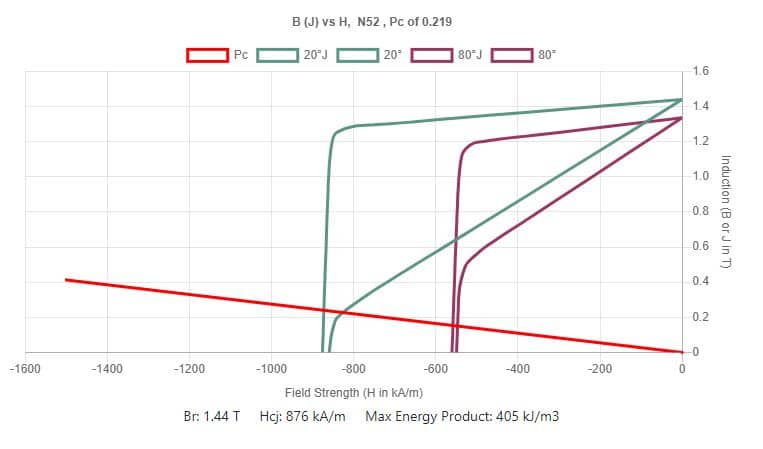Understanding Magnetic Permeance Coefficient
By Paul Fears | 03 June 2024
Firstly, it is important to understand that the maximum working temperature of a NdFeB magnet is not defined by the material grade!
It is essential to calculate the magnetic permeance coefficient to establish what grade of material you need. The two examples compare the same magnet but with different thicknesses, one at 30mm and one at 3mm. Ask yourself the following two questions while reviewing the graphs;
- I thought N50 was good to 80°C?
- Why will a 30mm x 3mm N52 disk magnet demagnetise at 80°C?
The Graphs
Example sample 1
- 30mm diameter x 30mm thick x N52 x 80°C;
- Magnet within the linear portion of the curve (intersection of Pc and 80°C bh curve);
- Linear = recoverable loss;

Example sample 2
- 30mm Diameter x 3mm thick x N52 x 20°C;
- Magnet will demagnetise at 80°C by around 30% (intersection of Pc and 80 deg Bh curve below the “knee” and no longer linear);

The Technical Explanation
First, familiarise yourself with the grades of NdFeB.
- M (80°C);
- H(120°C);
- SH(1500°C);
- UH(180°C);
- EH (200°C);
- AH (220°C);
On the data sheet these have maximum working temperatures with apparently clearly defined values. Nothing could be further from the truth. What is clearly defined is the normal and intrinsic coercivity. These are measurable values as shown on a permeameter.
The maximum working temperature is not defined by the material grade, but by the amount of “work” that you are trying to get out of the magnet. Magnets “work” by pushing field out into free space and the harder that is to do the more work is needed and the more easily a magnet is to demagnetise.
This topic will deal only with how geometry affects the permeance coefficient or the working point of the magnet. Other things that affect the Pc are external magnetic fields and external temperature.
For the example above, the data sheet shows a maximum magnet temperature of 80°C for an N52 grade, but if you compare the same material, the same diameter, at the same temperature, but vary the thickness, you get a magnet that is more susceptible to demagnetisation.
The worked example should leave you asking your internal design team “what is the working point of my magnet in my application and what coercivity do I need?”
The answer to this question will ensure you get the right performance at the right price. Selecting the right material as early on in the development process will inevitably reduce the total timescale.
The Magnetic Permeance Coefficient
Magnetic permeance coefficient, often denoted as Pc, is a measure used in the design of magnetic circuits. It is defined as the ratio of magnetic flux density Bd to magnetic field strength Hd at the operating point on the B-H curve of a magnet. This coefficient helps to express the “operating point,” or “operating slope,” of the magnet on the B-H curve, which is crucial for understanding how the magnet will perform under different conditions. It should be noted that the permeance coefficient of a single body magnet is largely affected by the magnet’s shape. Considering a cylindrical shape, the greater the ratio of diameter to thickness the more easily the magnet is demagnetised.
Related Technical Article
Magnet and Magnet Assembly Design
Bunting designs and manufactures a wide range of magnet setters, magnetisers, magnets and magnetic assemblies. Many are bespoke for specific applications. For further information on any of the products mentioned in this article, or for bespoke magnet assemblies and magnet designs, please contact us via:
Phone: +44 (0) 1442 875081
Email: sales.berkhamsted@buntingmagnetics.com
Via Bunting-eMagnets for online purchase of Magnets and Magnetic Technology
Follow us for all our latest news on Social Media



